Patient Retention Stewardship in Real world Evidence Studies: the Pentad of P's Model
Authored by Amit Kumar
Abstract
Real World Evidence (RWE) studies generate data that
helps fill the knowledge gap between clinical trials and actual clinical
practice setting. RWE studies generate data across different age
groups, races, ethnicities, varying severities, unstudied co-morbid
conditions, differing concomitant drugs (including OTC medications),
lifestyle variations and differing adherence/compliance patterns. RWE
studies are across very large number of patients and therefore may help
unearth rarer ADRs which are not evident in relatively smaller
populations in clinical trials.
By definition the RWE studies are across larger and
more diverse populations than the more controlled setting of Clinical
trials which are conducted across a relatively smaller number of
subjects. Given that controls are lesser in real world setting of actual
practice, it is difficult to enrol and more importantly retain patients
in these real world studies. The very basis of these real world studies
is to generate rich data from a larger population and patient retention
being a challenge, the results RWE study would lose significance if the
challenges of retention are not addressed at the very beginning. This
article is an endeavour to discuss various risk factors affecting
patient retention and suggests a practical approach by the entire study
team to effectively address and mitigate these risks.
Introduction
The main purpose of drug development is to bring
drugs and devices to market faster and improve patient's health
outcomes. But what happens once those drugs and devices are in the
market? Real World Evidence (RWE) provides deep insight into how a drug
is actually used and how it performs in the "real world" with all its
variety of settings and circumstances. RWE is obtained from real world
evidence studies, which may be of various types (Table 1)
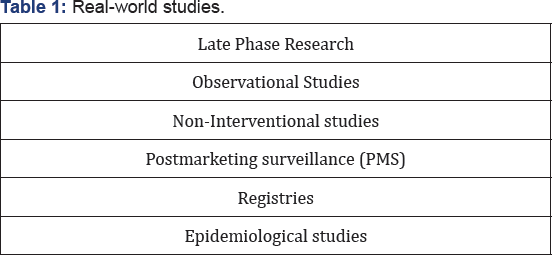
Factors Affecting Study Success
There Are Many Factors, Which Can Affect Study Success
(Table 2)

Importance of retention
While patient recruitment is often highlighted as the
key aspect in ensuring study success, the area of patient retention in
RWE studies is often overlooked. Retention of patients throughout the
life of study is however critical from scientific as well as economic
point of view. Retaining as many patients as possible should be a
priority since it directly affects the statistical power of the study.
Some reasons for subject dropout are within
the control of study or can be addressed through careful study design
and during conduct of the study.
Factor Affecting Retention
Retention Stewardship
A good retention plan needs stewardship by Sponsor,
CRO & Sites. This is done through a good patient retention plan,
which can be developed at the initiation of the study and that can be
implemented throughout the life of the study to mitigate patient
retention risks. There paper emphasizes on 5 key elements Table 3 which can lead to good retention stewardship.
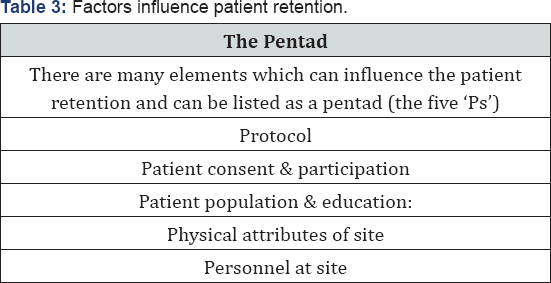
Protocol
A study protocol is a document that describes, in
detail, the plan for conducting the study. The study protocol explains
the purpose and function of the study as well as how to carry it out.
During protocol development, sponsors should consider how the study
design will translate into patient burden for study participants. The
number of study visits, complexity of the tasks the patient must
perform, and the convenience of the site location can all build into
unrealistic patient burden that leads to early discontinuation from the
study.
A proactive approach to integrate into the study
design phase is to conduct a feasibility or Panel discussion with NCI/
study chair person & SC members (National Co-ordinating Investigator
& Steering Committee Members), which comprises of experience
Investigators of the country. This group can offer the sponsor insights
into patient perceptions & practical challenges of the study. A
Sponsor can pen down common questions and seek clarity during the
discussion. There are few questions mentioned in Table 4.
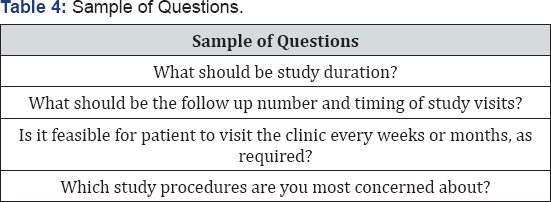
The investigator meeting can also provide an
interactive forum for all PIs & site staff to exchange successful
strategies for addressing patient concerns.
Patient consent & participation
At the time a patient consents to participate in a
study, the consent process should be a detailed discussion or
explanation of what will occur during the conduct of the study, risks
and benefits, study duration, Number of follow-ups and timing of study
visits and potential side effects. The principal investigator is key to
setting the right tone at this first visit. Recognizing and addressing a
patient's concern during consent process and throughout the study is
important to retain the patient till study completion. During the
consent process if a patient has a fear, it has to be addressed by the
principal investigator who listens to and answers their questions
Patient population and education
Patient population for a study depends on the disease
prevalence in the surrounding areas of the site. For example, there are
good transport facilities in plain areas versus hilly areas, so studies
which require frequent follow up will have better retention in the
plains. At present almost all the studies require educated patients. For
example, diabetes studies design includes patient's diary or
questionnaires for collection of information regarding blood glucose
values and other patient reported outcomes such as quality of life. This
means that site with lot of illiterate patients will not be able to
retain patients because they need support to fill the details and in
long term they can feel it's a burden or pressure
Physical attributes of site
Recruiting a large number of participants and
retaining them in the study usually requires involvement of a
considerable number of centres. However, all centres need to have a
patient pool of adequate size and the infrastructure and resources to
recruit and manage the projected numbers of patients efficiently
Site resources: One should assess personnel
resources including the number and type of personnel available, their
functional responsibilities, and their relationships to other
institutional departments, referring physicians and community
organizations. Participating research clinics need to be centrally
located, easily accessible, well organised and efficient in scheduling
tests, collecting information and so on. They should offer flexible
appointment times and sufficient time with the clinical trial staff for
participants to adequately understand the study's rationale, its
requirements and risks and have all their questions answered.
Site facilities and procedures: Site facilities & procedures can also affect patient's retention like
• Availability and responsiveness of site staff; Patients will
feel more secure having 24/7 access to trained study staff.
• Convenient timing of appointments: Will facilitate patient’s
compliance with the study schedule and prevent missed
visits.
• Logistic issues can also lead to study procedure's fatigue
and patients may lose their interest in participation further.
Personnel at site
Though the PI is responsible for the conduct of the
study however the Study Co-ordinator (SC) is the heart and soul of the
study and that, ultimately, it is the SC who carries forward the
research goals and play a significant role in the success of the study.
Employing an experienced and dedicated SC at each participating centre
is key to successful recruitment, retention, and reduces the time
demanded of investigators. Same site personnel/SC throughout the study
duration helps to facilitate trusting relationship with the patient. SC
should be skilled at verbal communication (in languages) and responding
to subjects’ questions and concerns.
Site experience: Past experience in conducting
studies in a similar patient population and assessment of past
enrolment & retention performance metrics is important in deciding
whether a site can fulfil the need.
Communications: Strategy of maintaining a
strong
communication with the patient over extended periods of time during the
study is essential. Patient retention involves great customer
relationships therefore SC should focus on creating a pleasant "Soft
Skills" experience for the subject. Patients are people too and treating
them in the same way as you would want to be treated will build trust
and confidence required to retain a patient in the study.
Use of Technology in Retention Plan
Technology solutions can provide a supportive role in
retention during the patient participation phase, ensuring the patient
has a positive experience at the clinical study site and this remains
critical for ongoing patient participation.
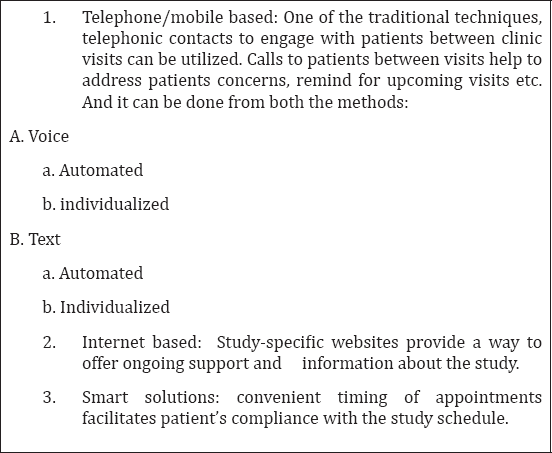
Some key points to keep patient engaged and motivated are listed in Table A.
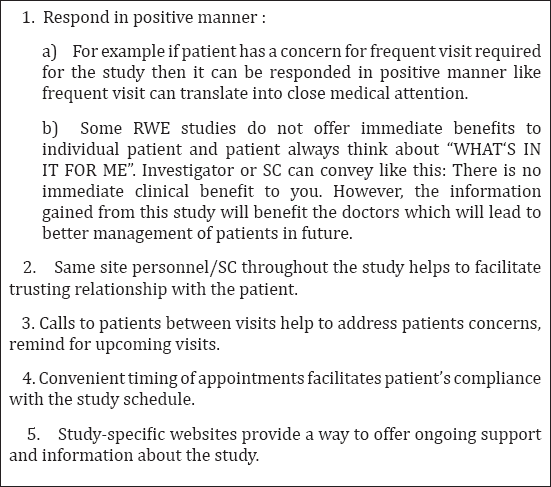
Conclusion
Patient motivation for participation in the study is
multifactorial and is a continuous process. Part of this process
includes reinforcing the study purpose and the value of their
participation at each study visit. The practices described above, may be
quite effective in identification and fixing the problem of patient
dropouts at the right time. The “Pentad of P's model” is a simple method
that Study Team (sponsors, CRO and sites) can use to prepare a good
retention plan, minimise the retention risks and ensure effective
retention stewardship.
To Know More About Current Research in Diabetes & Obesity
Journal Please click on:
https://juniperpublishers.com/crdoj/index.php
https://juniperpublishers.com/crdoj/index.php



Expected to form you a next to no word to thank you once more with respect to the decent recommendations you've contributed here.dental clinic in chennai
ReplyDelete